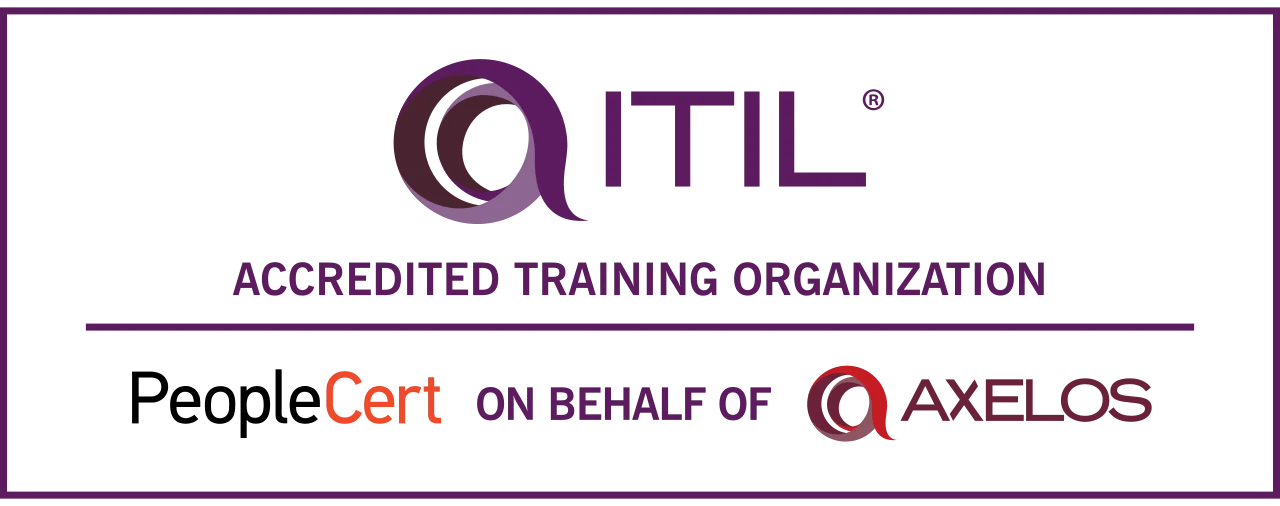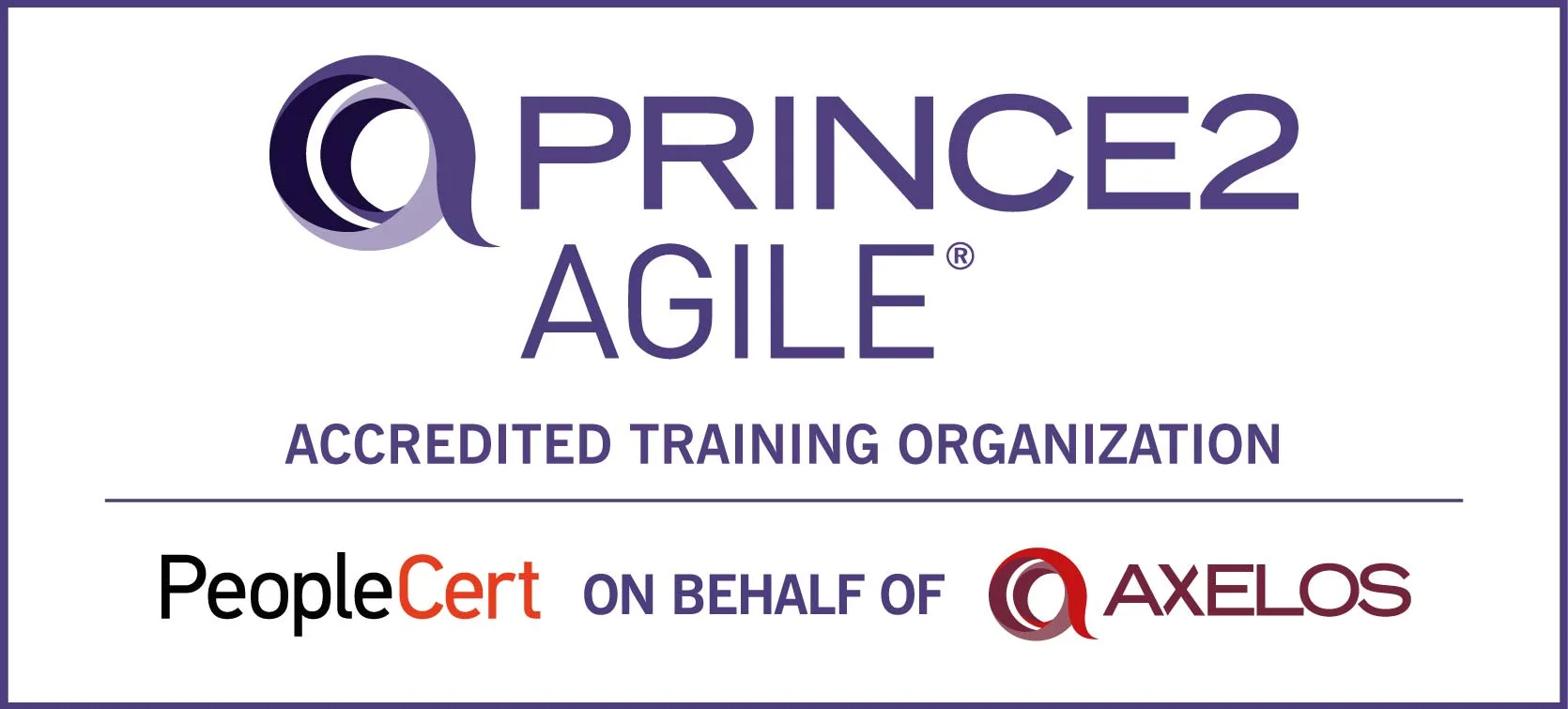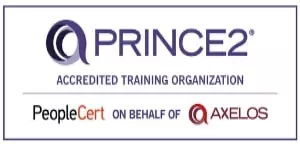- What Is Toil in SRE? Understanding the Hidden Workload
- The SRE Impact of Toil on Reliability and Team Performance
- Identifying and Measuring Toil in SRE Operations
- Proven Strategies to Reduce Toil in SRE
- Tools and Frameworks for SRE toil Reduction
- Benefits of Reducing Toil
- Toil Management Strategies for Long-Term Success
- Key Metrics to Measure Toil Reduction Success
- Case Studies: Real-World Examples of Toil Reduction
- Conclusion
Your system’s stable, but your SREs are exhausted. They’re stuck firefighting issues instead of building better systems. That hidden workload? It’s SRE toil, and it’s time to fix it. In simple terms, SRE toil is the repetitive, manual work that scales with your services but adds no lasting value. From restarting servers to handling the same alerts repeatedly, toil consumes engineering time that could be spent improving systems or designing new features.
This blog walks you through what toil SRE really looks like, how it affects your team and business, and proven strategies for SRE toil reduction. You’ll also learn how to measure it, the tools that make automation easier, and real-life case studies that show the difference automation can make.
The strategies in this blog align with Google’s SRE principles, widely recognized as industry standards for operational reliability. Google recommends keeping toil below 50% of engineering time, a benchmark adopted by leading tech organizations globally. Following these best practices ensures that your SRE efforts meet industry-proven methodologies.
What Is Toil in SRE? Understanding the Hidden Workload
Not all work is equal. In SRE, toil is a specific type of work that drains teams without producing long-term benefits. Here’s what defines it:
1. Manual: Tasks that require human intervention but could be automated.
- Example: restarting a failed service or rerunning scripts.
2. Repetitive: Tasks done often with little variation.
- Example: resolving the same incident dozens of times.
3. Automatable: Tasks that could be scripted or systemized but remain manual.
- Example: repeated data cleanup or deployment steps.
4. Tactical: Quick fixes that don’t solve the underlying problem.
- Example: patching a server without addressing root causes.
5. No Enduring Value: Once completed, the task doesn’t contribute to lasting improvements.
- Example: manually applying the same configuration repeatedly.
6. Scales with Service Growth (O(n)): As systems grow, toil grows linearly or exponentially, making it impossible to manage manually.
In short, SRE toil grows as your services grow. The only sustainable way to tackle it is through thoughtful automation and process improvement.
The SRE Impact of Toil on Reliability and Team Performance
SRE toil isn’t just a time sink — it affects reliability, morale, and business outcomes. Here’s how:
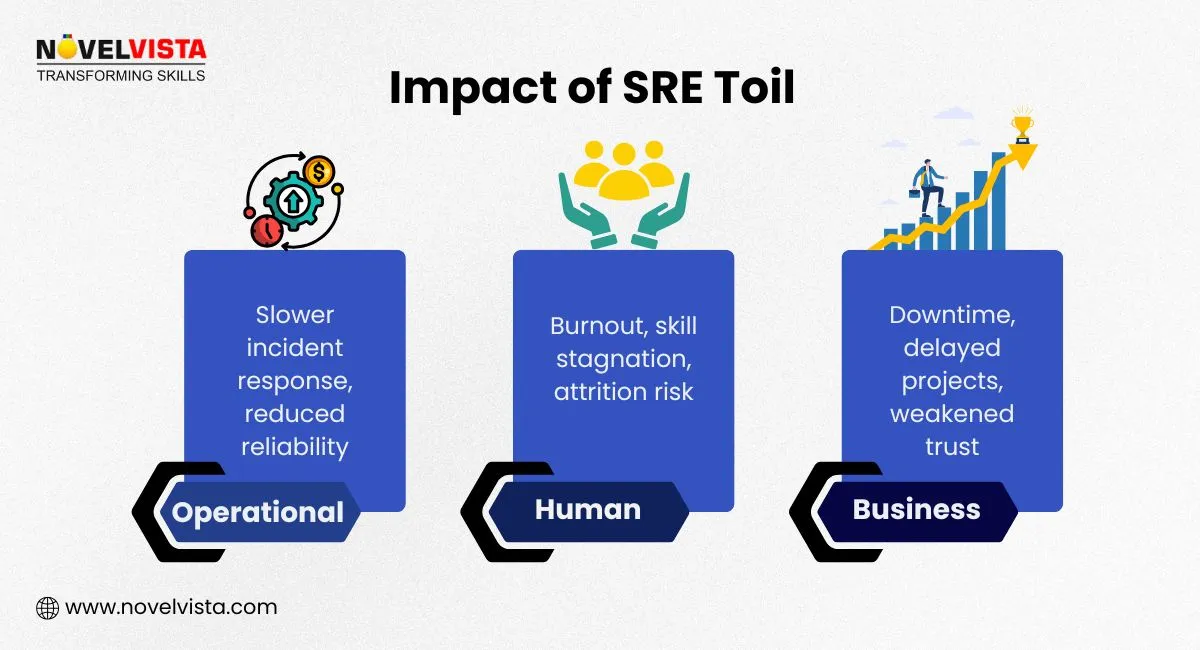
Operational Impact:
- Slows incident response and deployments.
- Causes workflow inconsistencies.
- Reduces overall system reliability.
Human Impact:
- Burnout and frustration from constant firefighting.
- Engineers are stuck in reactive work, slowing skill growth.
- Attrition risk rises, harming long-term team stability.
Business Impact:
- Downtime increases, risking SLA breaches.
- Delays digital transformation and scalability initiatives.
- Trust between engineering and leadership erodes.
SRE Toil Reduction Playbook
Cut the busywork and boost innovation.
Learn proven strategies to measure, automate, and
eliminate toil in your SRE workflows.
Identifying and Measuring Toil in SRE Operations
Tracking and measuring toil is essential for effective SRE toil reduction. Google recommends keeping toil below 50% of total engineering work. Here’s how to do it:
How to Identify Toil
- Repetitive Alerts: Frequent alerts for the same issue indicate repetitive manual work that can be automated to save engineering time.
- Manual Deployments: Repeated manual deployment steps drain productivity and increase the chance of errors, highlighting tasks suitable for automation.
- Recurring Hotfixes: Continuously fixing the same incidents without addressing root causes is a clear sign of toil and inefficiency in operations.
How to Measure Toil
- Track Hours: Record hours spent on toil per sprint or release to quantify the hidden workload and set automation priorities.
- Task Categorization: Separate tasks into Toil vs Engineering Work to visualize what SRE Activities add enduring value versus repetitive effort.
- Toil Audits: Conduct retrospectives or audits to review recurring manual tasks and identify automation opportunities.
Proven Strategies to Reduce Toil in SRE
Reducing toil SRE requires focused automation and process improvement. Key strategies include:
- Automate Repetitive Tasks: Eliminate manual steps using Infrastructure as Code tools like Terraform, Ansible, and CI/CD pipelines such as Jenkins and GitLab.
- Self-Healing Systems: Implement automated remediation for common failures like service restarts, failovers, or minor incident resolutions.
- Standardize Templates: Reusable playbooks, runbooks, and deployment templates streamline operations and reduce repetitive engineering work.
- Improve Observability: Leverage ML-driven AIOps tools for alert correlation, predictive monitoring, and proactive incident prevention.
- Shift to Self-Service: Replace ticket queues with automated portals to empower teams to resolve common issues independently.
- Root-Cause Focus: Treat repeated incidents as automation opportunities instead of temporary fixes, addressing the underlying problems for long-term efficiency.
By applying these strategies, teams can reduce SRE toil, improve reliability, accelerate deployments, and free up engineers to work on high-value initiatives.
Tools and Frameworks for SRE toil Reduction
Choosing the right tools makes SRE toil reduction practical and measurable. Key categories include:
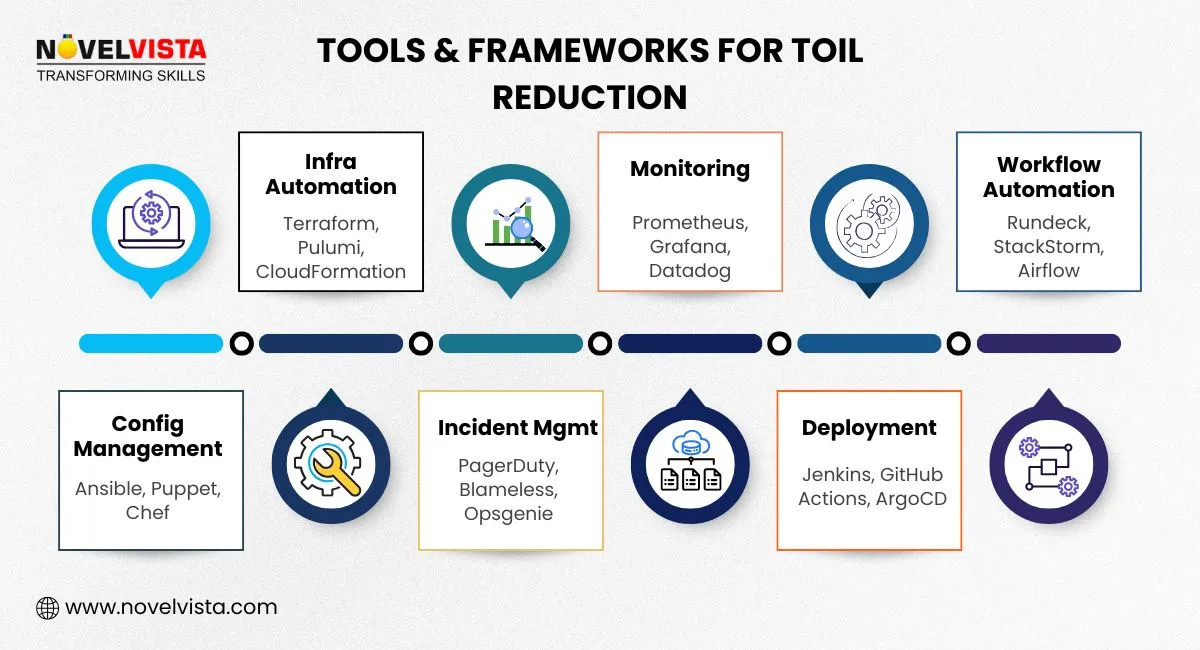
- Infrastructure Automation: Terraform, Pulumi, AWS CloudFormation help automate server provisioning and configuration tasks.
- Configuration Management: Chef, Puppet, and Ansible manage system states and reduce repetitive manual changes.
- Monitoring & Alerting: Prometheus, Grafana, Datadog, and New Relic provide insights and help correlate alerts efficiently.
- Incident Management: PagerDuty, Opsgenie, Blameless, and xMatters automate notifications and improve incident response.
- Workflow Automation: Rundeck, StackStorm, and Airflow allow automated job execution and operational orchestration.
- Code & Deployment: Jenkins, GitHub Actions, and ArgoCD streamline deployments and reduce repetitive manual steps.
Benefits of Reducing Toil
Reducing SRE toil brings measurable advantages for both organizations and professionals:
For Organizations
- Improved Reliability: Systems are more stable as fewer manual errors occur.
- Faster Deployments: Automation accelerates rollouts and reduces downtime.
- Higher Productivity: Teams focus on innovation instead of repetitive firefighting.
- Enhanced Trust: Developers, operations, and business teams align better with predictable systems.
For SRE Professionals
- Better Morale: Reduced burnout and frustration from repetitive tasks.
- Career Growth: Engineers spend time on meaningful projects, improving skills and experience.
- Job Satisfaction: Focusing on engineering challenges instead of routine toil increases motivation.
- Recognition: Teams that successfully reduce toil demonstrate measurable business impact.
Toil Management Strategies for Long-Term Success
Sustainable SRE toil reduction requires a strategic approach:
- Periodic Toil Reviews: Conduct quarterly audits to identify remaining automation gaps.
- Automation Sprints: Allocate fixed time in each sprint specifically for automating manual tasks.
- Ownership Frameworks: Define responsibilities for automating and maintaining workflows.
- KPI Integration: Include toil reduction metrics in performance goals for teams and individuals.
- Iterative Culture: Measure results, refine processes, and continuously improve instead of seeking perfection immediately.
Key Metrics to Measure Toil Reduction Success
Tracking metrics ensures SRE toil reduction efforts are effective:
- Manual Interventions %: Proportion of incidents handled manually versus automatically.
- Toil vs Engineering Hours: Percentage of time spent on toil compared to high-value engineering work.
- MTTR Improvement: Reduction in Mean Time to Recovery due to automated systems.
- Automation Frequency: Number of incidents resolved automatically versus manually.
- Deployment Velocity: Increase in release frequency thanks to automation.
- Time Saved per Cycle: Hours saved through automation per sprint or release.
- Automation ROI: Compare time/effort saved to engineering costs invested in automation.
Case Studies: Real-World Examples of Toil Reduction
Case Study 1: Reducing Toil in Google’s Datacenters
Google engineers faced a rising manual workload in datacenter maintenance, especially in repairing failed network line cards. As infrastructure scaled, repetitive “drain-repair-undrain” tasks created human errors and operational delays.
To solve this, Google built automated repair systems that:
- Detected failures, drained traffic safely, and triggered auto-repairs.
- Used automated risk assessments to minimize outages.
- Reduced human intervention to only hardware replacement steps.
With the Jupiter fabric, automation became smarter, handling reboots, verifications, and hardware installs automatically. This cut toil drastically, reduced downtime, and freed engineers for innovation.
Key Takeaways:
- Start small; improve automation iteratively.
- Always include automated risk checks.
- Design modular, reusable workflows.
- Accept “good enough” automation; perfection can delay progress.
- Maintain ongoing review and training for legacy systems.
(Source: Google SRE)
Case Study 2: Decommissioning Legacy Home Directories
Case Study 2: Decommissioning Filer-Backed Home Directories
Summary:
Google’s Corp Data Storage (CDS) SRE team eliminated operational toil by decommissioning legacy filer-backed home directories used for over 14 years.
Toil Reduction Strategies:
- Decommission legacy systems
- Promote toil reduction as a feature
- Gain management and peer support
- Replace manual workflows with self-service
- Start small and improve with feedback
Challenge:
Legacy NFS/CIFS filers were expensive, latency-prone, and incompatible with Google’s BeyondCorp security model. Managing shares, access, and troubleshooting created heavy toil for CDS engineers.
Solution:
The team launched Project Moira, an iterative, multi-phase migration from filers to modern tools like Google Drive, Team Drive, Cloud Storage, Piper, and internal systems. Key enablers included:
- Moonwalk for analyzing usage data
- Moira Portal for user communication and self-service migration
- Automation for archiving, deactivating, and deleting shares
Impact:
- Reduced home directories from 65,000 to ~50
- Retired costly hardware and ticket-based workflows
- Improved user experience and data security
Key Lessons:
- Regularly challenge legacy processes — eliminate instead of optimizing toil
- Build self-service portals to replace manual tickets
- Begin with human-backed automation and refine gradually
- Standardize systems (“melt snowflakes”) for automation scalability
- Use organizational nudges and transparent communication to drive adoption
(Source: Google SRE)
Conclusion
Reducing SRE toil is not just about automation; it’s about creating scalable reliability and freeing engineers to focus on innovation. Effective toil reduction improves system stability, team morale, and overall business performance. Organizations benefit from faster deployments, fewer incidents, and stronger operational alignment, while SRE professionals gain meaningful work and clear career growth.
Next Step:
Take control of toil in your systems. Enroll in NovelVista’s SRE Foundation Training or SRE Practitioner Certification to master practical SRE toil reduction techniques, automation strategies, and industry best practices. Build systems that work smarter, not harder.
Frequently Asked Questions
Author Details

Vaibhav Umarvaishya
Cloud Engineer | Solution Architect
As a Cloud Engineer and AWS Solutions Architect Associate at NovelVista, I specialized in designing and deploying scalable and fault-tolerant systems on AWS. My responsibilities included selecting suitable AWS services based on specific requirements, managing AWS costs, and implementing best practices for security. I also played a pivotal role in migrating complex applications to AWS and advising on architectural decisions to optimize cloud deployments.
Confused About Certification?
Get Free Consultation Call






